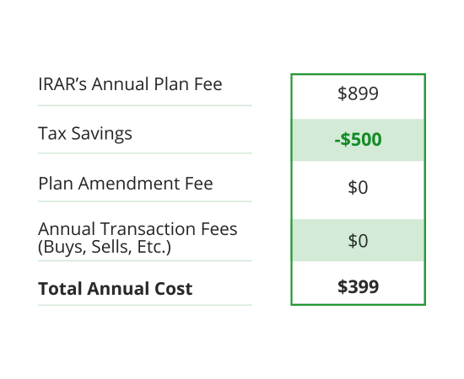The Solo 401(k) Auto-Enrollment Credit You Shouldn't Overlook

If your current plan doesn’t include the required auto-enrollment feature, you can amend it to qualify. IRAR offers the platform and support to help you do just that.
What Is the Solo 401(k) Auto-Enrollment Credit?
This IRS tax credit allows you to claim $500 annually for three consecutive years if your Solo 401(k) includes an Eligible Automatic Contribution Arrangement (EACA). Unlike a tax deduction, which reduces taxable income, a tax credit directly reduces your tax liability, providing more impactful savings.
Key Benefits
- Up to $1,500 in Tax Savings: Claim $500 per year for three years.
- Dollar-for-Dollar Tax Reduction: More impactful than a deduction.
- Promotes Consistent Saving: Auto-enrollment encourages regular contributions with the flexibility to opt out if you choose.
Eligibility Requirements
To qualify for this credit:
- You must have a Solo 401(k) or one-participant 401(k) plan.
- The plan must include an auto-enrollment feature (EACA).
(Note: Solo 401(k)s are typically for self-employed individuals without employees, making them well-suited for this credit.)
How to Update Your Plan to Qualify
If your current Solo 401(k) lacks auto-enrollment, you don’t need to start over. You can amend your existing plan.
IRAR Trust Company offers a flexible platform that supports auto-enrollment and helps ensure compliance with IRS rules. With IRAR, your plan will include:
- Add Auto-Enrollment to your plan.
- Maintain IRS compliance with proper documentation.
- Access diverse investment options, including alternative assets.
If your current provider doesn’t support these features, IRAR can assist in updating your plan—without needing to roll over assets or pay a high fee to amend your plan.
How to Claim the Credit
- Ensure Auto-Enrollment: Confirm your Solo 401(k) includes an EACA.
- Complete and include IRS Form 8881: Submit this form with your tax return to determine the credit.
- Claim the $500 Credit on IRS Form 3800 Part III Line 1dd
- Amend Your Plan if Needed: Work with IRAR to add auto-enrollment if it’s not currently included.
Example of Cost and Savings
Dr. Sarah, a self-employed consultant, updates her Solo 401(k) to include auto-enrollment in 2025 by moving her plan to IRAR. She claims the $500 credit each year through 2027, saving a total of $1,500. This offsets administrative costs and helps streamline her retirement planning.

Why Now?
The SECURE 2.0 Act mandates auto-enrollment for 401(k) plans starting in 2025. By adopting the IRAR Solo 401(k) platform, you will automatically qualify for the Tax Credit as well as sign up for a robust 401(k) recordkeeping platform not offered by most providers.
By taking action early, you can maximize tax savings and ensure your plan remains aligned with evolving regulations.
Next Steps
- Review Your Plan: Check whether your Solo 401(k) includes auto-enrollment.
- Amend if Necessary: Work with a provider like IRAR to update your plan.
- File IRS Form 8881 and IRS Form 3800 with your tax return: Don’t miss your opportunity to claim the credit.
Want to learn more or amend your plan? Visit IRAR’s Solo 401(k) platform to explore your options.









Comments (0)